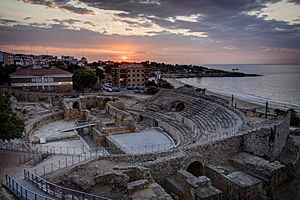Tarragona Amphitheatre facts for kids

View of the amphitheatre
|
|
| Location | Tarragona, Spain |
|---|---|
| Region | Hispania Tarraconensis |
| Coordinates | 41°6′53″N 1°15′33.50″E / 41.11472°N 1.2593056°E |
| Type | Roman amphitheatre |
| Official name: Amphitheatre, basilica, and Romanesque church | |
| Type: | Cultural |
| Criteria: | ii, iii |
| Designated: | 2000 (24th session) |
| Part of: | Archaeological Ensemble of Tárraco |
| Reference #: | 875-007 |
| Region: | Europe and North America |
| Official name: Anfiteatro | |
| Type: | Non-movable |
| Criteria: | Monument |
| Designated: | 5 August 1924 |
| Reference #: | RI-51-0000298 |
The Roman Amphitheatre of Tarraco was a huge arena in the ancient Roman city of Tarraco. Today, this city is called Tarragona in Spain. It was the capital of a large Roman area called Hispania Tarraconensis.
This amazing building was constructed around the 100s AD, close to the city's main public square. It was about 130 meters long and 102 meters wide, big enough for 15,000 people! People came here to watch exciting gladiator fights and battles between animals, or even people fighting animals.
Today, it's mostly in ruins, but it's a very important historical place. In 2000, UNESCO declared it a World Heritage Site as part of the Archaeological Ensemble of Tárraco. This means it's a special place that needs to be protected for everyone to see.
Contents
History of the Amphitheatre
Building the Arena
The amphitheatre was built between the late 1st century AD and the early 2nd century AD. It was placed outside the city walls, right by the sea. You can still see parts of a large inscription from the 3rd century AD, which was added during the time of Elagabalus, a Roman emperor.
Changes Over Time
In 259 AD, something sad happened here. During a time when Christians were treated badly by Emperor Valerian, the city's bishop, Fructuosus, and his helpers, Augurius and Eulogius, were burned alive in the amphitheatre.
Later, when Christianity became the main religion of the Roman Empire, the amphitheatre was no longer used for gladiator fights. Some of its stones were used to build a church to remember the three martyrs. People were even buried in the arena, and special tombs were built next to the church.
Periods of Abandonment and Recovery
When the Islamic invasion of Spain began, the area around the amphitheatre was left empty for a long time, until the 12th century. Then, a new church was built on top of the old one, in a style called Romanesque. This church was later taken down in 1915.
In 1576, the amphitheatre area became a convent for a religious group called the Trinity. It stayed that way until 1780, when it was turned into a prison for people who were working on building the port. After the prison closed, the site was abandoned again until the mid-20th century. That's when work began to restore and uncover the ancient theatre, with help from the Bryant Foundation.
See also
 In Spanish: Anfiteatro de Tarraco para niños
In Spanish: Anfiteatro de Tarraco para niños
de:Tarraco#Das Amphitheater

